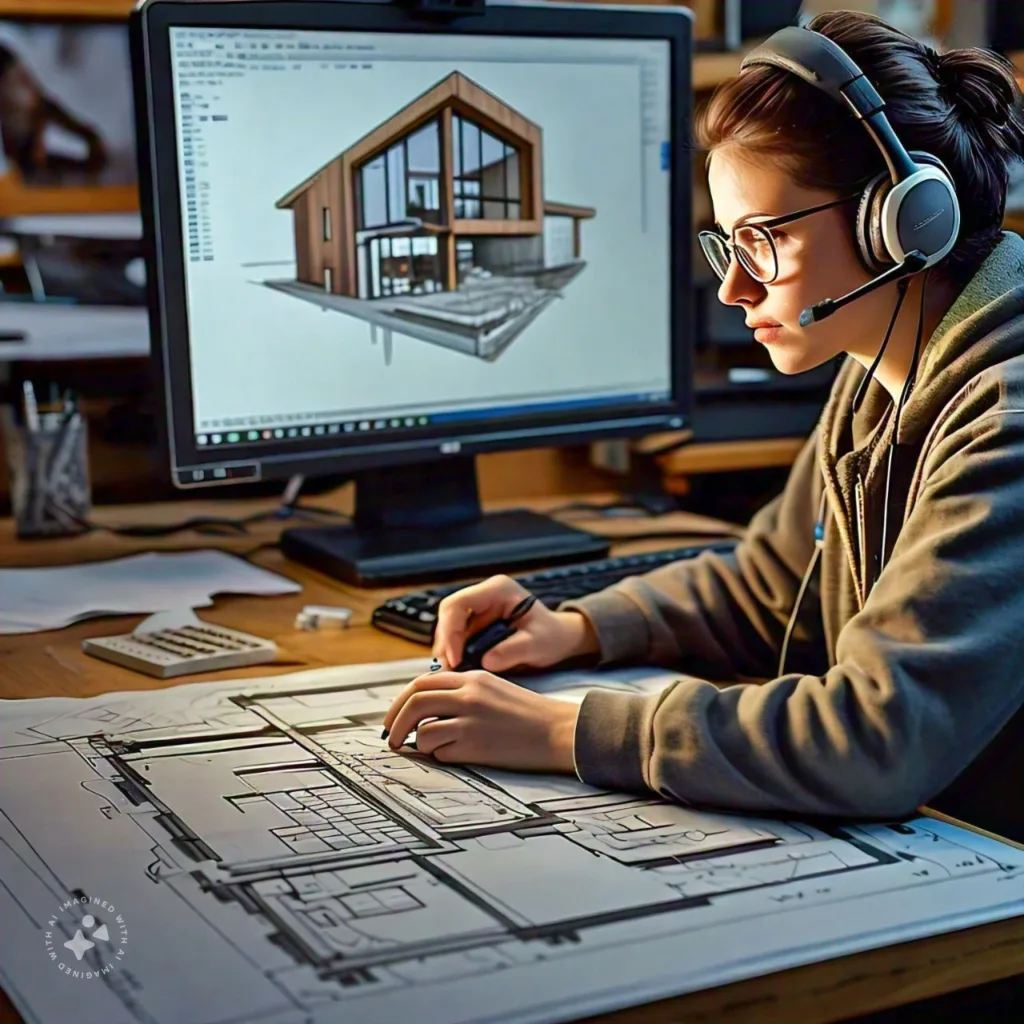Introduction
AutoCAD is widely recognized for its precision in drafting, but it also offers powerful rendering tools that can bring architectural models to life. By applying materials, adjusting lighting, and using the built-in rendering engine, AutoCAD allows architects and designers to create realistic visualizations of their projects. This guide will walk you through the essential techniques for rendering architectural models in AutoCAD, focusing on the use of materials, lighting, and rendering settings to produce professional-quality results.
Table of Contents
Why Use AutoCAD for Architectural Rendering?
While AutoCAD is often associated with 2D drafting and technical drawings, its 3D rendering capabilities are essential for creating photorealistic models that help clients and stakeholders visualize the design. Rendering in AutoCAD allows you to:
- Visualize Realistic Designs: Show how materials, light, and space interact in a realistic environment.
- Improve Client Presentations: Provide detailed renderings that make your designs easier to understand and more compelling.
- Refine Design Elements: Identify potential design issues through realistic renderings before construction begins.

Setting Up the 3D Model for Rendering
Before you can render your architectural model, it’s important to ensure that your 3D model is properly set up.
Creating the 3D Model
- Start with Accurate 2D Plans: Begin by importing or creating 2D floor plans, sections, and elevations. Use these drawings as a reference for building the 3D model.
- Using 3D Modeling Commands: Use essential AutoCAD commands like
EXTRUDE,REVOLVE,SWEEP, andLOFTto create 3D elements of the building. For example:- Walls: Use the
EXTRUDEcommand to turn 2D lines representing walls into 3D objects with thickness and height. - Roofs: Create sloped or curved rooflines using the
LOFTorSWEEPcommands to generate complex geometries. - Doors and Windows: Insert 3D door and window blocks or create custom ones using basic 3D shapes.
- Walls: Use the
Organizing the Model with Layers
- Layer Management: Organize different elements of your model—such as walls, floors, windows, and furniture—on separate layers. This makes it easier to apply different materials and manage the visibility of objects during rendering.
- For example, create layers named Walls 3D, Windows 3D, Doors 3D, and Roof 3D for clarity.
Setting Up Views
- Defining Camera Views: Use the
CAMERAcommand to set up different views of the model. Placing cameras at key viewpoints helps you present the most important aspects of your design during the rendering process.- After placing a camera, adjust the view using the ViewCube or the
3DORBITcommand to ensure you capture the best angle of your model.
- After placing a camera, adjust the view using the ViewCube or the
- Save Named Views: To quickly switch between various render perspectives, save views using the
VIEWcommand. This helps maintain consistency when rendering different parts of your model.
Applying Materials in AutoCAD
Materials are critical to creating realistic architectural renderings. By applying textures and finishes to surfaces, you can simulate real-world materials like brick, wood, glass, and concrete.
Accessing the Material Browser
- Material Browser: Open the Material Browser by typing
MATERIALSinto the Command Line or accessing it from the Visualize tab on the Ribbon. The Material Browser allows you to select, create, and edit materials for your model.
Applying Predefined Materials
AutoCAD includes a library of predefined materials that you can apply directly to your model.
- Select an Object: Click on the object or surface to which you want to apply a material (e.g., a wall or a window).
- Assign a Material: In the Material Browser, find the appropriate material (e.g., brick, wood, metal) and click Assign to Selection. The material will be applied to the selected object.
- Preview the Material: Switch to a shaded view by typing
VISUALSTYLESand choosing Realistic to see how the material looks on your model.
Creating Custom Materials
If the predefined materials don’t meet your specific needs, you can create custom materials.
- Create a New Material: In the Material Browser, click Create New Material and select the type of material you want to create (e.g., a new wood finish or custom glass).
- Set Material Properties: Customize the material by adjusting properties such as texture, color, reflectivity, transparency, and bump mapping (which adds depth and texture to surfaces). Upload a texture image file if you want to apply specific patterns or finishes.
- Apply the Material: Once you’ve created the material, apply it to the desired object just like a predefined material.
Lighting Techniques in AutoCAD
Lighting is a crucial aspect of rendering, as it affects how materials and spaces are perceived in a 3D model. AutoCAD allows you to use both natural and artificial lighting to enhance your architectural renderings.
Types of Lights in AutoCAD
- Sunlight: Simulate natural sunlight by setting up the sun’s position based on geographic location and time of day. This is useful for architectural renderings that need to show natural light effects.
- Point Lights: These lights emit light uniformly in all directions from a single point. They’re ideal for simulating light sources like bulbs and lamps.
- Spotlights: Spotlights emit light in a specific direction, simulating focused light sources such as recessed lights or directional lighting.
- Distant Lights: These lights simulate sunlight or moonlight, as they cast parallel rays over a large distance. They’re ideal for exterior views of a building.
Setting Up Sunlight for Natural Lighting
- Turn on Sunlight: Open the Visualize tab and click Sun & Location to enable sunlight for your scene.
- Specify Location: Set the geographic location of your project, which allows AutoCAD to simulate realistic sunlight based on the time of year and the building’s orientation.
- Adjust Sun Settings: Use the Sun Properties palette to adjust the time of day and date to see how the light interacts with your building throughout the day. For example, early morning or evening light casts longer shadows, which can dramatically change the feel of your render.
Using Artificial Lighting
- Insert Point Lights: To simulate artificial indoor lighting, use the
POINTLIGHTcommand. Place point lights where light fixtures would be in real life, such as ceiling lights or floor lamps. - Insert Spotlights: Use
SPOTLIGHTto focus light on specific areas like artwork, architectural features, or entranceways. - Adjust Light Properties: For each light, adjust the intensity, color, and shadows in the Properties palette. This ensures that the lighting looks natural and doesn’t overpower the model.
Rendering the Model in AutoCAD
Once materials and lighting are set up, it’s time to render your model to create a photorealistic image.
Setting Up the Rendering Environment
- Render Presets: AutoCAD offers various rendering presets that control the quality of your final image. Go to the Render tab in the Ribbon and choose from options such as Draft, Low, Medium, or High quality.
- For initial previews, use lower quality settings to save time. For final presentations, choose High to produce detailed, photorealistic results.
- Render Output Settings: Use the Render Output panel to choose the resolution and format for your rendered image. Higher resolutions (such as 1920×1080 pixels) are ideal for large-format prints or presentations, while lower resolutions work for web-based images or quick previews.
Performing the Render
- Start the Render: Type
RENDERin the Command Line or select Render from the Ribbon. AutoCAD will begin rendering the scene, calculating how light interacts with the materials and objects in the model. - Render Time: Depending on the complexity of your model and the quality settings you’ve chosen, rendering may take several minutes to complete. Keep an eye on the progress bar to see how long the render will take.
- Save the Rendered Image: Once rendering is complete, save the image in your desired format (e.g., PNG, JPEG, or TIFF) by clicking Save Rendered Image in the Render window.
Post-Rendering Adjustments
Even after rendering, you may want to make final adjustments to your image.
- Adjust Exposure: Use AutoCAD’s Exposure Settings to tweak brightness, contrast, and saturation directly within the rendered image.
- Apply Filters: If needed, export your rendered image into an external image-editing program like Adobe Photoshop for further adjustments, such as sharpening or color correction.
Tips for Effective Architectural Rendering in AutoCAD
- Simplify the Model: To speed up rendering, hide unnecessary details or elements that won’t be visible in the final render. Use layers to control visibility.
- Test Renders at Lower Quality: Use lower-quality rendering settings for initial test renders to save time. Adjust lighting, materials, and camera angles before committing to a high-resolution render.
- Focus on Key Details: Ensure that important architectural elements, like material finishes and lighting, are well-represented in the render. Clients appreciate detail and realism, particularly in areas like textures, shadows, and reflections.
Conclusion
Rendering architectural models in AutoCAD allows architects and designers to create detailed, realistic visualizations of their projects. By mastering materials, lighting, and rendering techniques, you can produce high-quality renders that enhance your presentations and make your designs more compelling. Whether you’re showcasing an exterior view with sunlight or an interior space with detailed lighting, AutoCAD’s rendering tools give you the flexibility and control to bring your architectural vision to life.
FAQs
- How do I apply materials to my AutoCAD model?
You can apply materials through the Material Browser. Select an object, choose a material from the library, and assign it to the selected object. - What is the best lighting setup for architectural rendering?
A combination of natural sunlight and artificial lighting is ideal. Use Sunlight for exteriors and Point Lights or Spotlights for interior lighting. - How do I improve rendering speed in AutoCAD?
Simplify the model by hiding unnecessary objects and use lower-quality render settings for test renders. For final renders, increase the quality settings. - Can I create custom materials in AutoCAD?
Yes, you can create custom materials by selecting Create New Material in the Material Browser. Adjust texture, color, reflectivity, and other properties to match your needs. - How do I render a high-quality image in AutoCAD?
Choose High quality from the render presets and set a high resolution (e.g., 1920×1080). Use appropriate lighting and materials for the most realistic results.

